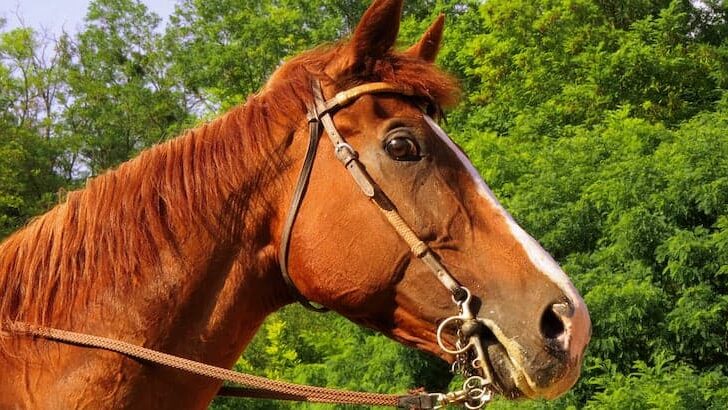Affiliate Disclaimer
As an Amazon Associate I earn from qualifying purchases. It helps me keep the website going. Thank you for your support.
Horses spook because they are flight animals, so it’s natural for them to be defensive and suspicious. A spooky horse will jump to the side in a startled fashion, sometimes called shying. This is often accompanied by a rapid turn of speed, usually involving going as fast as possible in the other direction.
There are lots of things that can help a spooky horse and its rider or handler, either separately or as a partnership. These range from health checks to management changes and assistive techniques like Clicker training and conventional schooling. Identifying the potential cause for spooking is the starting point.
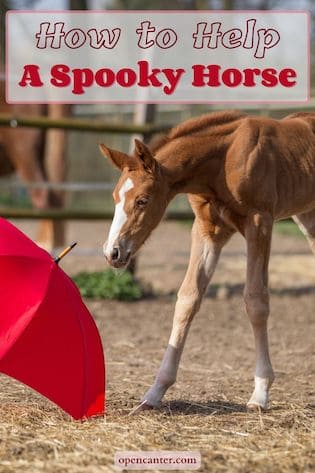
Why Are Some Horses Spooky?
Horses spook when in hand and under saddle, which can be frustrating. It can also lead to handler or rider injuries and a loss of confidence.
A horse spooking or shying away is a natural reaction to something that the horse views as untrustworthy or downright dangerous, and you probably won’t.
Take a moment to watch horses at liberty in the field. They will often run to the furthest point and then turn around and look at whatever the perceived invader is. It could be a large and unfamiliar bird that’s landed or a flapping bag that’s blown in off the road nearby.
Spooking is stereotypical horse behavior, so should we be curbing it or punishing a horse for doing what comes naturally?
What are the Characteristics of Spooky Horse Behavior?
One of the things you can consistently rely on with a spooky horse is that their behavior is often inconsistent! Here are some typical equine character traits which many horse owners and riders will recognize.
- Horses spook at a familiar object like a wheelbarrow in an unfamiliar place. Leave one in the middle of the arena and see what happens next time you ride. Try their rug over the arena fence
- Horses can spook and become difficult as a response to specific sounds that they don’t like. Spooking doesn’t have to be sight-orientated
- Distant objects can cause as much of an issue as something nearby if the horse decides he doesn’t like it
- A horse will spook at something he has walked past repeatedly on previous occasions. Usually, this is because there are other contributing factors like he is fresh or it’s a windy day
- A horse that spooks at an object on a hack going away from home will spook again on the return journey. This is because he is passing it on the other side even though he has seen it before
- A horse will go past something very spooky and ignore it, like a mini digger with the engine on. What about an inflatable Christmas decoration on a house? He’ll then spook at something utterly insignificant like a feather or an upturned stone
- Color and pattern can incite spooky behavior. It is usually contrasts and patterns more than specific colors, such as white flowers in a ditch. Also, a corner of a field that is paler than the surrounding area can cause spooking.
- Shapes and patterns cause some horses to react. That’s why show jumping course builders use fillers which these unusual designs
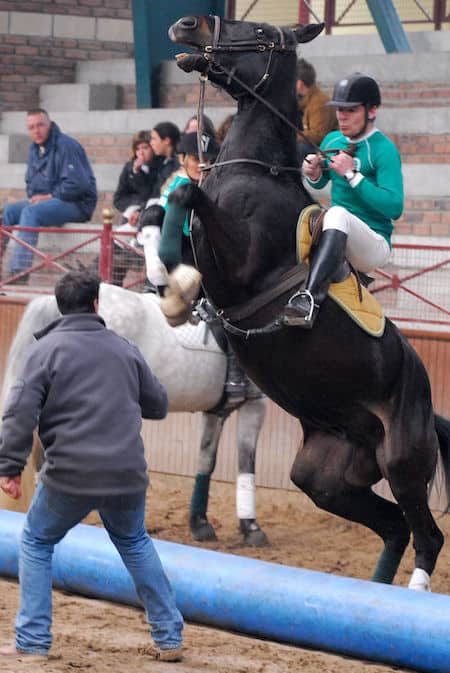
CC BY-SA 2.0, via Wikimedia Commons
Why are Some Horses More Spooky Than Others?
Horses with ‘more blood’ like Thoroughbreds tend to be more highly strung than placid types like cobs and native pony breeds. They might be sharper and tend to spook. However, this is a bit of a generalization and not one to be relied on.
Age is relevant because young horses are less experienced. Grazing or hacking out with an older horse is an excellent technique to help young or ‘green’ horses. They may be unconfident when faced with something they have never seen before.
Weather is a great button pusher for horses. Some become unsettled when it’s windy or stormy and will spook at things that usually wouldn’t bother them. When it comes to spooking, it’s often a combination of factors. The rider or handler isn’t always aware of what they all are.
Horses that have had a past bad experience will usually spook at the same object repeatedly. They may associate their bad experience with an object which may not have had anything to do with it.
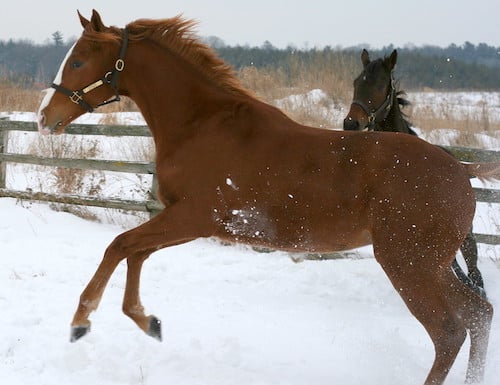
Spooking is Natural for Horses
Spooking behavior is a natural reaction in the horse. However, some horses certainly exploit it, and it just gets worse. This can pose a problem to riders and handlers, who need to be more confident and skilled to deal with it.
Some horses spook almost because they enjoy it. They are feeling well and confident and just full of life. The first thing to try and figure out is why your horse is spooking.
Several different reasons can cause repeated spooking at a variety of objects:
- The handler or rider is not skilled enough to manage the horse – horses quickly learn to take advantage
- The rider or handler is not confident. Horses can feel uneasy when people are unconfident with them, and can become difficult in these situations
- There could be a mismatch between diet, exercise, turnout, and work levels. Spooking may not be the only thing you have to worry about!
- Your horse may react to specific objects simply because he doesn’t like them
Spooky horses are not fun to ride for most people and can cause riders to lose confidence and become defensive. This can spiral into a worsening situation that won’t improve without professional help.
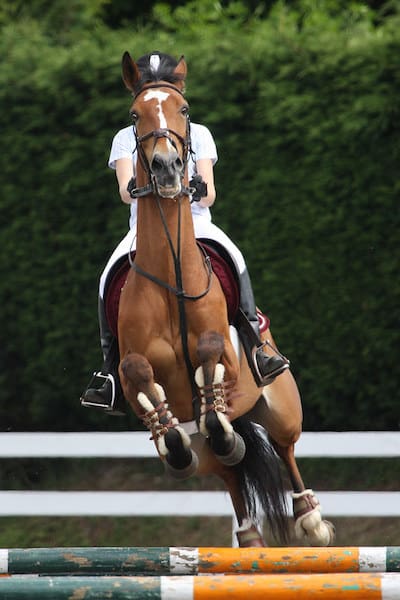
Helping the Spooky Horse
A spooky horse may have a genuine fear of a particular object. This is often based on a bad experience or a rider who has not been able to manage the situation effectively.
Exposing the horse to this issue can be done with a chilled-out companion who is not worried about that particular object. In time, the horse can gradually become more confident.
This technique is often used to manage the horse in all types of potentially tricky situations like shoeing, clipping, and loading. It works on the twin principles of time and patience.
Clicker training is a recognized technique that has worked very well in certain areas of equestrianism. This uses a bridging signal to indicate the moment of desired behavior, followed by positive reinforcement.
This is more effective than training with negative reinforcement or punishment. Clicker training rewards the horse for doing the right thing.
Helping the Rider
Helping the rider manage their spooky horse will empower them. With the best will in the world, it’s impossible to stop a horse from spooking at absolutely everything. Teaching the rider how to handle the situation will make them feel more confident.
A targeted program of professional help can help both horse and rider de-spook. This may involve the rider having a break and riding a more straightforward horse. The spooky horse can be ridden by a stronger rider to improve behavior.
A more experienced rider who is not worried will give the horse confidence. They can stop the horse from exploiting opportunities which could be the case with a less-established rider. There is a fine line between fear and naughtiness.
It’s about managing the horse in a safe and sympathetic way, ultimately sending him forward and past that scary object.
Spooking isn’t personal. Often, a horse and rider partnership can be polarised into a battle. This can be deconstructed quite easily with the correct input.
You also don’t need to replicate a specific object of worry unless there has been a particular problem. You need to teach the rider to manage the horse when faced with anything he doesn’t like. That’s relatively easy for a competent instructor or trainer to do in a safe environment.
Final Thoughts
If spooking is becoming more than occasional or you feel you or your horse are not coping, ask a third-party and independent professional for help. It’s essential to look at the situation in the round to rule out any possible areas of pain.
A spooky horse might be difficult going because of pain caused by a missed injury or an ill-fitting saddle. Perhaps he is not confident in the rider or handler. A holistic view of the horse is always the best starting point, especially with behavioral problems.

